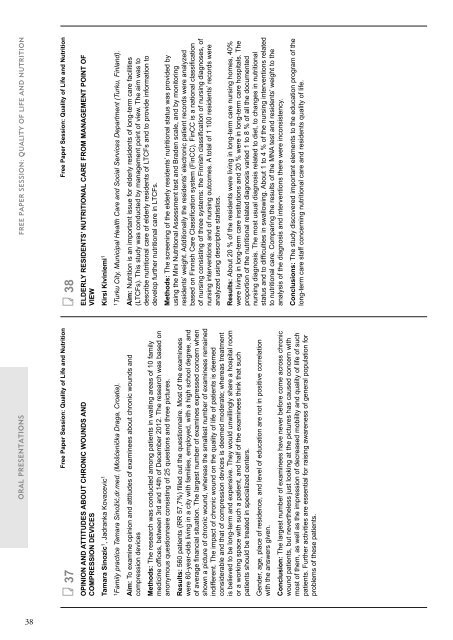You also want an ePaper? Increase the reach of your titles
YUMPU automatically turns print PDFs into web optimized ePapers that Google loves.
ORAL PRESENTATIONS<br />
37<br />
OPINION AND ATTITUDES ABOUT CHRONIC WOUNDS AND<br />
COMPRESSION DEVICES<br />
Free Paper Session: Quality of Life and Nutrition<br />
Tamara Sinozic 1 , Jadranka Kovacevic 1<br />
1 Family practice Tamara Sinožić,dr.med. (Mošćenička Draga, Croatia).<br />
Aim: To examine opinion and attitudes of examinees about chronic wounds and<br />
compression devices<br />
Methods: The research was conducted among patients in waiting areas of 10 family<br />
medicine offices, between 3rd and 14th of December 2012. The research was based on<br />
anonymous questionnaire consisting of 25 questions and three pictures.<br />
Results: 560 patients (RR 57,7%) filled out the questionnaire. Most of the examinees<br />
were 60-year-olds living in a city with families, employed, with a high school degree, and<br />
of average financial situation. The largest number of examines expressed concern when<br />
shown a picture of chronic wound, whereas the smallest number of examinees remained<br />
indifferent. The impact of chronic wound on the quality of life of patients is deemed<br />
considerable and that of compression devices is deemed moderate; whereas treatment<br />
is believed to be long-term and expensive. They would unwillingly share a hospital room<br />
or a working space with such a patient, and half of the examinees think that such<br />
patients should be treated in specialized centers.<br />
Gender, age, place of residence, and level of education are not in positive correlation<br />
with the answers given.<br />
Conclusion: The largest number of examinees have never before come across chronic<br />
wound patients, but nevertheless just looking at the pictures has caused concern with<br />
most of them, as well as the impression of decreased mobility and quality of life of such<br />
patients. Further activities are essential for raising awareness of general population for<br />
problems of these patients.<br />
FREE PAPER SESSION: QUALITY OF LIFE AND NUTRITION<br />
38<br />
Free Paper Session: Quality of Life and Nutrition<br />
ELDERLY RESIDENTS’ NUTRITIONAL CARE FROM MANAGEMENT POINT OF<br />
VIEW<br />
Kirsi Kiviniemi 1<br />
1 Turku City, Municipal Health Care and Social Services Department (Turku, Finland).<br />
Aim: Nutrition is an important issue for elderly residents of long-term care facilities<br />
(LTCFs). This study was conducted by management point of view. The aim was to<br />
describe nutritional care of elderly residents of LTCFs and to provide information to<br />
develop further nutritional care in LTCFs.<br />
Methods: The screening of the elderly residents’ nutritional status was provided by<br />
using the Mini Nutritional Assessment test and Braden scale, and by monitoring<br />
residents’ weight. Additionally the residents’ electronic patient records were analyzed<br />
based on Finnish Care Classification system (FinCC). FinCC is a national classification<br />
of nursing consisting of three systems: the Finnish classification of nursing diagnoses, of<br />
nursing interventions and of nursing outcomes. A total of 1 100 residents’ records were<br />
analyzed using descriptive statistics.<br />
Results: About 20 % of the residents were living in long-term care nursing homes, 40%<br />
were living in long-term care institutions and 20 % were in long-term care hospitals. The<br />
proportion of the nutritional related diagnosis varied 1 to 8 % of all the documented<br />
nursing diagnosis. The most usual diagnosis related to diet, to changes in nutritional<br />
status and to difficulties in swallowing. About 1 to 4 % of the nursing interventions related<br />
to nutritional care. Comparing the results of the MNA test and residents’ weight to the<br />
analysis of the diagnosis and interventions there were inconsistency.<br />
Conclusions: The study discovered important elements to the education program of the<br />
long-term care staff concerning nutritional care and residents quality of life.<br />
38






